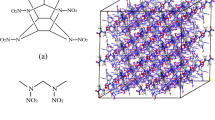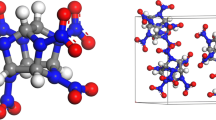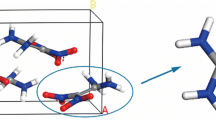Abstract
Context
3,4-Bisnitrofurazanfuroxan (DNTF) is a typical high energy density compound (HEDC), it has high crystal density and detonation parameters, but also high mechanical sensitivity. To decrease its mechanical sensitivity, the DNTF based polymer bonded explosives (PBXs) was designed. The pure DNTF crystal and PBXs models were established. The stability, sensitivity, detonation performance and mechanical properties of DNTF crystal and PBXs models were predicted. Results show that PBXs models containing fluorine rubber (F2311) and fluorine resin (F2314) have higher binding energy, meaning that DNTF/F2311 and DNTF/F2314 is relatively more stable. PBXs models have higher value of cohesive energy density (CED) than pure DNTF crystal, DNTF/F2311 and DNTF/F2314 have the highest value of CED, implying that the sensitivity of PBXs is effectively decreased, DNTF/F2311 and DNTF/F2314 is more insensitive. PBXs have lower crystal density and detonation parameters than DNTF, the energy density is declined, DNTF/F2314 has higher energetic performance than other PBXs. Compared with pure DNTF crystal, engineering moduli (tensile modulus, shear modulus, bulk modulus) of PBXs models are obviously decreased, but Cauchy pressure is increased, implying that the mechanical properties of PBXs is superior to pure DNTF component, the PBXs containing F2311 or F2314 have more preferable mechanical properties. Consequently, DNTF/F2311 and DNTF/F2314 have the best comprehensive properties and is more attractive among the designed PBXs, indicating that F2311 and F2314 are more advantageous and promising in ameliorating properties of DNTF.
Methods
The properties of DNTF crystal and PBXs models were predicted through molecular dynamics (MD) method under Materials Studio 7.0 package. The MD simulation was performed with isothermal-constant volume (NVT) ensemble, and the force field was chosen as COMPASS force field. The temperature was set as 295 K, the time step was 1 fs and the total MD simulation time was 2 ns.








Similar content being viewed by others
Data Availability
All data generated or analyzed during this study are included in this article.
Code Availability
Not applicable.
References
Dong HS, Zhou FF (1984) High energy explosives and correlative physical properties. Science Press, Bei**g
Mathieu J, Stucki H (2004) Military high explosives. Int J Chem 58:383–389
Boyd S, Gravelle M, Politzer P (2006) Nonreactive molecular dynamics force field for crystalline hexahydro-1,3,5-trinitro-1,3,5 triazine. J Chem Phys 124:104508
Xu XJ, **ao JJ, Huang H, Li JS, **ao HM (2010) Molecular dynamic simulations on the structures and properties of ε-CL-20 (0 0 1)/F2314 PBX. J Hazard Mater 175:423–428
Tao J, Wang XF (2017) Molecular dynamics simulation for fluoropolymers applied in ε-CL-20-based explosive. J Adhes Sci Technol 31:250–260
Lu YY, Shu YJ, Liu N, Lu XM, Xu MH (2018) Molecular dynamics simulations on ε-CL-20-based PBXs with added GAP and its derivative polymers. RSC Adv 8:4955–4962
Shu Y, Zhang SW, Shu YJ, Liu N, Yi Y, Huo JC, Ding XY (2019) Interactions and physical properties of energetic poly-(phthalazinone ether sulfone ketones) (PPESKs) and ε-hexanitrohexaazaisowurtzitane (ε-CL-20) based polymer bonded explosives: a molecular dynamics simulations. Struct Chem 30:1041–1055
**ao JJ, Zhu W, Ma XF, **ao HM, Huang H, Li JS (2008) A novel model for the molecular dynamics simulation study on mechanical properties of HMX/F2311 polymer-bonded explosive. Mol Simul 34:775–779
**ao JJ, Zhang H, Huang H, Li JS, Zhu W, **ao HM (2008) NPT ensemble MD simulation investigation on the mechanical properties of HMX/F2311 polymer-bonded explosive. Chin J Chem 26:1969–1972
**ao JJ, Wang WR, Chen J, Ji GF, Zhu W, **ao HM (2012) Study on structure, sensitivity and mechanical properties of HMX and HMX-based PBXs with molecular dynamics simulation. Comput Theor Chem 999:21–27
**ao JJ, Li SY, Chen J, Ji GF, Zhu W, Zhao F, Wu Q, **ao HM (2013) Molecular dynamics study on the correlation between structure and sensitivity for defective RDX crystals and their PBXs. J Mol Model 19:803–809
Zhu W, **ao JJ, Zhu WH, **ao HM (2009) Molecular dynamics simulations of RDX and RDX-based plastic-bonded explosives. J Hazard Mater 164:1082–1088
Ma S, Li YJ, Li Y, Luo YJ (2016) Research on structures, mechanical properties, and mechanical responses of TKX-50 and TKX-50 based PBX with molecular dynamics. J Mol Model 22:43
Yu YH, Chen SS, Li X, Zhu JP, Liang H, Zhang XX, Shu QH (2016) Molecular dynamics simulations for 5,5′-bistetrazole-1,1′-diolate (TKX-50) and its PBXs. RSC Adv 6:20034–20041
Zhou MN, Chen SS, Wang DX, Yu YH, Wang JQ, Li JX, Wang N, Chen ML (2019) A comparative study of performance between TKX-50-based composite explosives and other composite explosives. J Energ Mater 37:162–173
Song XY, **ng XL, Zhao SX, Ju XH (2020) Molecular dynamics simulation on TKX-50/fluoropolymer. Modell Simul Mater Sci Eng 28:015004
Wang JY, ** SH, Chen SS, Li LJ, Wang DX, Lu ZY, Wang N, Wang JF (2018) Molecular dynamic simulations for FOX-7 and FOX-7 based PBXs. J Mol Model 24:145
Huang Y, Guo QJ, Gou RJ, Zhu SF, Zhang SH, Yuan XF, Chen YH (2022) Theoretical investigation on interface interaction and properties of 3-nitro-1,2,4-triazol-5-one (NTO)/fluoropolymer polymer-bonded explosives (PBXs). Theor Chem Acc 141:74
Huang Y, Gou RJ, Zhang SH, Yuan XF, Chen YH (2022) Comprehensive theoretical study on safety performance and mechanical properties of 3-nitro-1,2,4-triazol-5-one (NTO)-based polymer-bonded explosives (PBXs) via molecular dynamics simulation. J Mol Model 28:1–16
Hu HX, Zhang ZZ, Zhao FQ, **ao C, Wang QH, Yuan BH (2004) A study of the properties and application of high energy density material DNTF. Acta Armamentarii 25:155–158
Zhou YS, Zhang ZZ, Li JK, Guan XR, Huang XP, Zhou C (2005) Crystal structure of 3,4-dinitrofurazanfuroxan. Chin J Explos Propellants 28:43–46
Bunte SW, Sun H (2000) Molecular modeling of energetic materials: the parameterization and validation of nitrate esters in the COMPASS force field. J Phys Chem B 104:2477–2489
Michael JM, Sun H, Rigby D (2004) Development and validation of COMPASS force field parameters for molecules with aliphatic azide chains. J Comput Chem 25:61–71
Andersen HC (1980) Molecular dynamics simulations at constant pressure and/or temperature. J Chem Phys 72:2384–2393
Allen MP, Tildesley DJ (1987) Computer simulation of liquids. Oxford University Press, Oxford
Ewald PP (1921) Evaluation of optical and electrostatic lattice potentials. Ann Phys 64:253–287
Mayo SL, Olafson BD, Goddard WA III (1990) Dreiding: a generic force field for molecular simulations. J Phys Chem B 94:8897–8909
Sun H (1994) Force field for computation of conformational energies, structures, and vibrational frequencies of aromatic polyesters. J Comput Chem 15:752–768
Casewit CJ, Colwell KS, Rappé AK (1992) Application of a Universal force field to organic molecules. J Am Chem Soc 114:10035–10046
Rappé AK, Colwell KS, Casewit CJ (1993) Application of a Universal force field to metal complexes. Inorg Chem 32:3438–3450
**ao JJ, Huang YC, Hu YJ, **ao HM (2005) Molecular dynamics simulation of mechanical properties of TATB/fluorine-polymer PBXs along different surfaces. Sci China Ser B Chem 48:504–510
Fu JB, Wang BG, Chen YF, Li YC, Tan X, Wang BY, Ye BY (2021) Computational analysis the relationships of energy and mechanical properties with sensitivity for FOX-7 based PBXs via MD simulation. R Soc Open Sci 8:200345
Guo YX, Zhang HS (1983) Nitrogen equivalent coefficient and revised nitrogen equivalent coefficient equations for calculating detonation properties of explosives: detonation velocity of explosives. Explos Shock Waves 3:57–65
Weiner JH (1983) Statistical mechanics of elasticity. John Wiley, New York
Wu JL (1993) Mechanics of elasticity. Tongji University Press, Shanghai
Watt JP, Davies GF, O’Connell RJ (1976) The elastic properties of composite materials. Rev Geophys Space Phys 14:541–563
Funding
This research was supported by Young Talent Fund of University Association for Science and Technology in Shaanxi, China (grant number 20200604).
Author information
Authors and Affiliations
Contributions
Gui-Yun Hang: Investigation, and writing-original draft.
Chao Lu: Investigation, and methodology.
**-Tao Wang: Visualization, and software.
Hai-Jian Xue: Simulation, and data analysis.
Tao Wang: Conceptualization, and methodology.
Wen-Li Yu: Reviewing, and editing.
Hui-Ming Shen: Modeling, and simulation.
Corresponding author
Ethics declarations
Competing interests
The authors declare no competing interests.
Conflict of Interest
The authors declared that no conflicts of interest existed in the article.
Additional information
Publisher's note
Springer Nature remains neutral with regard to jurisdictional claims in published maps and institutional affiliations.
Appendix 1
Appendix 1
Nitrogen equivalent coefficient of different detonation products, chemical bonds and chemical groups.
Table
5,
6,
Rights and permissions
Springer Nature or its licensor (e.g. a society or other partner) holds exclusive rights to this article under a publishing agreement with the author(s) or other rightsholder(s); author self-archiving of the accepted manuscript version of this article is solely governed by the terms of such publishing agreement and applicable law.
About this article
Cite this article
Hang, GY., Lu, C., Wang, JT. et al. Theoretical Prediction on Properties of 3,4-Bisnitrofurazanfuroxan (DNTF) Crystal and its Polymer Bonded Explosives (PBXs) Through Molecular Dynamics (MD) Simulation. J Mol Model 29, 169 (2023). https://doi.org/10.1007/s00894-023-05577-6
Received:
Accepted:
Published:
DOI: https://doi.org/10.1007/s00894-023-05577-6




